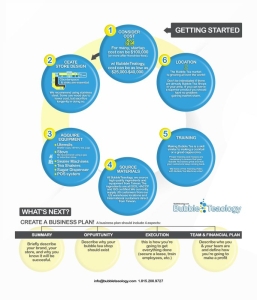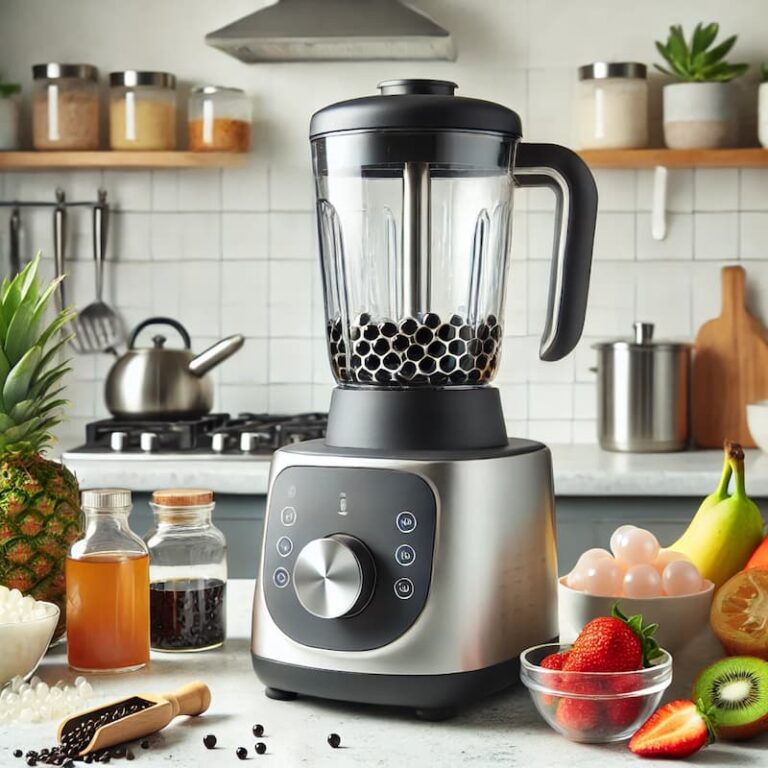

Learn how to maintain your bubble tea blender for peak performance with these expert tips on cleaning, maintenance, and troubleshooting.
Investing in the right bubble tea blender is the foundation for maintaining its peak performance. A high-quality blender ensures your drinks are blended efficiently and consistently while reducing the need for frequent repairs.
When selecting a blender, focus on models designed for commercial use. Look for features like powerful motors (at least 2 horsepower), durable stainless-steel blades, and variable speed settings to handle various ingredients. A pulse option is a bonus for blending ice without over-processing it. Noise reduction is also key in customer-facing environments, so consider models with sound enclosures to maintain a pleasant atmosphere in your shop.
Commercial bubble tea shops demand heavy-duty performance, which makes durability non-negotiable. Choose blenders made from high-grade materials like metal or impact-resistant plastics to withstand daily use. A robust warranty is equally essential, as it signals the manufacturer’s confidence in their product and provides a safety net for unexpected breakdowns.
A high-quality blender ensures consistency, a hallmark of any successful bubble tea shop. Cheaper blenders may fail to crush ice evenly or blend powders thoroughly, leading to subpar drinks and dissatisfied customers. Quality blenders not only last longer but also save money over time by reducing downtime and repair costs.
Proper cleaning is the simplest way to extend the life of your bubble tea blender. A quick yet thorough daily routine ensures your blender performs flawlessly while maintaining hygiene standards.
Start by unplugging the blender to ensure safety. Disassemble the jar, lid, and blade assembly. Rinse each part under warm water to remove residue immediately after use. Use a soft sponge with mild dish soap to scrub the jar and blades thoroughly. Avoid abrasive pads that can scratch surfaces. After cleaning, rinse all parts with warm water and dry them with a soft towel or let them air dry.
Using the right cleaning products can prevent unnecessary damage. Avoid harsh chemicals, bleach, or abrasive cleaners, as they can degrade materials like plastic or dull the blades. Opt for a food-safe, non-toxic detergent specifically designed for commercial kitchen use to ensure both safety and effectiveness.
To prevent residue buildup, clean the blender immediately after each use. If sticky ingredients like syrups or powders are involved, pre-rinse the jar before washing to loosen stuck particles. For hard-to-reach spots, use a small brush or toothbrush. Always ensure the blade assembly is cleaned thoroughly, as lingering residue can lead to unpleasant odors or contamination.
While daily cleaning is essential, a weekly deep cleaning routine ensures your blender remains in top-notch condition. This process targets hard-to-reach areas and prevents long-term wear and tear.
Start by unplugging the blender and disassembling all removable parts, including the jar, lid, blade assembly, and gaskets. Carefully inspect each component for hidden residue or wear. Soak the parts in warm, soapy water for about 10 minutes to loosen any stubborn buildup. Use a brush to clean tight crevices around the blades and under the gaskets. Rinse thoroughly and let all parts dry completely before reassembling.
Examine the blades for dull edges or signs of corrosion, which can hinder blending efficiency. Check the gaskets for cracks or brittleness, as damaged seals can lead to leaks. Look over the jar for scratches or cloudiness, which may indicate it’s time for a replacement. Promptly replacing worn parts helps prevent further damage and keeps your blender performing like new.
If your blender’s manual specifies, apply food-safe lubricant to the motor coupling and blade assembly. This reduces friction and ensures smooth operation, especially in high-use environments. Be careful not to over-lubricate, as excess oil can attract debris. Always use a lubricant recommended by the manufacturer to avoid compatibility issues.
Regular maintenance keeps your bubble tea blender running smoothly and minimizes unexpected breakdowns. A proactive approach ensures consistent performance and reduces long-term repair costs.
Loose or misaligned blades can lead to uneven blending or unusual noises during operation. Periodically inspect the blade assembly to ensure it’s securely fastened. If you notice any wobbling or movement, tighten the blade base according to the manufacturer’s instructions. Regular checks can also prevent leaks and maintain blending efficiency.
Strange noises or excessive vibrations during operation often signal underlying issues. These could include worn bearings, loose components, or misaligned parts. Address these signs immediately to prevent more severe damage. Turn off the blender, inspect it for visible problems, and contact the manufacturer for guidance if necessary.
Over time, components like blades, gaskets, or jars can wear out, affecting performance. Keep spare parts on hand for quick replacements to avoid disrupting your operations. Consult the manufacturer’s guidelines to source compatible parts and follow the instructions for installation to ensure optimal functionality.
Even with regular maintenance, occasional issues with your bubble tea blender are inevitable. Learning how to troubleshoot these problems can save time and keep your operations running smoothly.
Overheating is a common issue in high-volume environments. To prevent this, avoid running the blender continuously for long periods. If overheating occurs, turn off the blender and allow it to cool completely before using it again. Ensure the vents around the motor base are clear of dust or obstructions to improve airflow. Regularly cleaning the motor housing can also help prevent overheating.
Dull blades lead to inconsistent blending, leaving chunks of ice or poorly mixed ingredients in your drinks. Replace dull blades promptly to maintain the quality of your beverages. For minor dullness, sharpening the blades with a professional tool or taking them to a specialist may restore their edge. Always ensure the blades are installed correctly after maintenance.
Motor issues often manifest as difficulty starting, strange noises, or a burning smell. If you suspect a motor problem, unplug the blender and inspect the base for visible signs of damage. Check the power cord for wear, and ensure the electrical outlet is functioning correctly. For persistent motor issues, contact the manufacturer or a professional technician to avoid further damage.
Proper storage not only keeps your blender safe but also ensures it’s always ready for use. Organized storage practices reduce wear and tear and protect your equipment from potential damage.
In high-traffic bubble tea shops, designate a dedicated space for your blender when not in use. Ensure this area is clean, dry, and free from any potential hazards like spills or heavy objects that could fall on the blender. Keep the blender cord neatly coiled to avoid tangles or accidental tripping.
During off-hours, ensure the blender jar, blades, and base are completely dry before storage to prevent rust or mold buildup. Place a protective cover over the blender to shield it from dust or debris. For added safety, unplug the blender to eliminate the risk of power surges or accidental operation.
Before storing, inspect the blender to confirm all components are intact and functioning correctly. Test the blender briefly to ensure it operates smoothly. Keeping spare parts nearby, such as blades and gaskets, ensures that minor issues can be addressed quickly, so the blender is always ready for the next shift.
To get the most out of your bubble tea blender, adopt habits that support durability and efficiency. These best practices will ensure consistent performance and reduce costly repairs over time.
Every blender comes with specific recommendations tailored to its design and capabilities. Read and follow the manufacturer’s manual to ensure you’re using the blender correctly. This includes guidance on speed settings, blending times, and compatible materials. Adhering to these instructions minimizes the risk of damage and ensures optimal performance.
Even with regular cleaning and maintenance, professional checkups are invaluable for spotting issues you might miss. Schedule annual inspections with a qualified technician to assess the motor, blades, and other critical components. These evaluations can identify wear and tear early, preventing costly downtime and extending the blender’s lifespan.
Downtime during peak hours can hurt your business. Keep a spare blender on hand to ensure uninterrupted service in case of unexpected malfunctions. Choose a model similar to your primary blender for consistency in operation and blending quality. This simple step can save you from losing customers and revenue during emergencies.
Maintaining your bubble tea blender for peak performance is crucial for delivering top-quality drinks and ensuring your operations run smoothly. From daily cleaning routines to professional maintenance checks, every step you take contributes to the longevity and reliability of your equipment.
A well-maintained blender not only keeps your drinks consistent but also reduces downtime and costly repairs. By following these practices, you’re investing in the success of your bubble tea shop and customer satisfaction.
Contact BubbleTeaology Today for premium bubble tea equipment, expert advice, and all the tools you need to keep your shop running smoothly. And if you’re curious about the origins and variety of bubble tea, check out this detailed Bubble Tea Wikipedia article.
Q: How often should I clean my bubble tea blender?
A: Clean your blender daily after each use and perform a deep cleaning weekly to remove residue and prevent buildup.
Q: What should I do if my blender starts making unusual noises?
A: Turn off the blender immediately and inspect the blades, motor, and assembly for any loose or worn-out parts. If the issue persists, consult the manufacturer or a professional technician.
Q: Can I use any cleaning product to clean my blender?
A: No, avoid harsh chemicals and abrasives. Use a mild, food-safe detergent to prevent damage to the blender’s components and ensure safety.
Q: How can I keep my blender’s blades sharp?
A: Regularly inspect the blades for dullness and replace or sharpen them as needed. Avoid blending non-recommended items, which can cause premature dulling.
Q: Should I keep a spare blender for my bubble tea shop?
A: Yes, having a spare blender ensures uninterrupted service during peak hours in case of unexpected malfunctions.
Copyright © 2023 BubbleTeaology. All Rights Reserved.